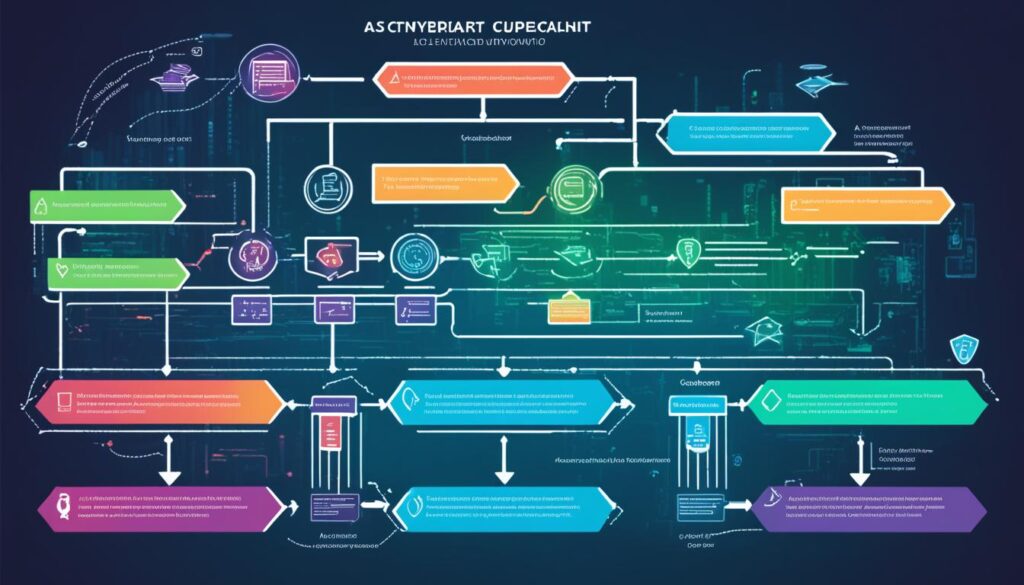Did you know that a staggering 97% of malware detected on computers leverages software’s digital signatures, misleading end-users into believing the software is legitimate? Such a statistic underscores the necessity of robust code signing practices. Code signing does not merely establish a digital handshake between software producers and consumers; it forms the backbone of software integrity and trust. By exploring the best practices for code signing, we dive into how code signing certificates, and diligent code signing process protocols, bolster the armamentarium against cyber threats.
Efficient code signing tools and methodologies are more than just a barrier against outsiders; they are watchtowers providing visibility and control over software’s fidelity. This security is paramount as the landscape of cyber threats continues to evolve with sophistication and stealth. In the following passages, we’ll explore the comprehensive code signing security measures that serve as the vanguards of cyber defense.
Key Takeaways
- Understanding the impact of code signing on software security and trust relations between consumers and producers.
- Highlights the criticality of protected code signing keys within the broader context of cybersecurity.
- Distinguishes the various layers of security measures in the code signing process, from certificate storage to signing authority verifications.
- Outlines the essential features and functionalities of code signing tools in maintaining the integrity of software distribution.
- Emphasizes the role of regular audits as preventive practices in the software security lifecycle.
Understanding the Role of Code Signing in Software Security
The diligence with which software developers and publishers approach the best practices for code signing speaks volumes about the importance of code signing in today’s digital ecosystem. As a shield against code tampering and impersonation, code signing helps in sustaining the authenticity and integrity of software, making it a linchpin for secure software distribution.
When developers sign their code with a digital signature, they not only certify that the code is genuine but also facilitate a verification mechanism for end users. Should the code be altered post-signing, the digital signature would no longer match, thus signaling tampering and potentially malicious activity.
In an age where software supply chain attacks are on the rise, maintaining the integrity of code signing processes is paramount. End users, ranging from individuals to vast enterprises, depend on the trust establishment that code signing promises. The reputation and dependability of software publishers hinge on their adherence to code signing protocols, underscoring its significance.
To illustrate the critical nature of code signing, consider this analogy:
Just as a wax seal in ancient times guaranteed the message within a letter remained unchanged from sender to recipient, code signing assures that the digital content remains untainted from its creation to its end use.
- Code signing asserts the identity of the publisher
- Preserves the originality of the code
- Deters unauthorized tampering or malware insertion
- Boosts user confidence in software security
- Is essential for maintaining trust in the software supply chain
Fostering a deep-rooted level of trust, code signing stands as a testament to a developer’s commitment to security and a user’s peace of mind when installing new software. It is an indispensable best practice for anyone involved in the creation or distribution of software.
Ensuring Secure Storage for Private Signing Keys
Protecting private keys utilized in code signing is paramount for the security of software and the prevention of unauthorized access. Employing stringent code signing security measures, including the use of a Hardware Secure Module (HSM), is an imperative step toward fortifying the integrity of code distribution.
Utilizing Hardware Security Modules (HSM)
The use of HSMs is a best practice for secure key storage that provides a dedicated hardware environment for cryptographic operations. As the CA/Browser Forum suggests, keys are less vulnerable to external threats when managed within a HSM’s robust, tamper-resistant boundaries. These secure devices assure that private keys are physically inaccessible to hackers and are only activated within the protected confines of the module.

Encrypting Keys When at Rest
In addition to HSMs, encrypting keys when at rest further secures them from potential compromise. Ensuring that private keys are encrypted with powerful algorithms is crucial to making unauthorized retrieval a nontrivial task for malicious actors. By combining encryption with HSM, organizations can set a robust security posture against sophisticated threats.
| Security Measure | Description | Benefit |
|---|---|---|
| Hardware Secure Module (HSM) | A physical device that manages and stores digital keys. | Provides physical security and a controlled environment for key management. |
| Encryption When at Rest | Additional layer of encoding that secures digital keys beyond the HSM. | Makes key retrieval complex, safeguarding against unauthorized access even if a breach occurs. |
It is essential to incorporate these code signing security measures to maintain the highest standards of digital security, prevent tampering, and uphold users’ trust in software integrity.
Maintaining Strict Access Control for Key Signing
In the realm of secure software deployment, adopting stringent access control measures is paramount. This involves the protection of code at its most vulnerable point: the signing process. Ensuring that only authorized personnel can sign code not only reinforces security but also fosters trust in the software’s integrity among stakeholders and users.
Implementing Multi-Factor Authentication (MFA)
One of the cornerstone code signing best practices is the implementation of Multi-factor Authentication (MFA). MFA provides a robust layer of defense, verifying the user’s identity through multiple pieces of evidence before granting access to sign code. This might include something the user knows (like a password), something the user has (such as a secure token), and something the user is (identified through biometrics).
Separation of Duties and Role-Based Access
Another essential protocol within code signing guidelines is the principle of the least privilege. Each role in the code signing process is allocated the least amount of access necessary to perform its function, creating a clear separation of duties. Role-based access control (RBAC) limits the power any individual has, reducing the risk of insider threats or the exploitation of high-level credentials. Adhering to these methods curtails unauthorized access and ensures that the code signing process remains inviolable and trustworthy.
Regular Audits of Code Signing Workflows
A meticulous approach to monitoring the code signing infrastructure must be taken through consistent audits, which serve as a critical component in the array of code signing best practices. These routine evaluations are a cornerstone in the code signing best practices checklist, aimed at reinforcing software security and reliability.
Structured audits enable organizations to trace the audit key signing workflows, documenting each signing activity and discerning any irregularities. This level of diligence is not only a technical necessity but also a strategic imperative to maintain the integrity of code signing operations.

Below is an essential checklist designed to aid in the thorough audit of code signing procedures:
| Checklist Item | Description | Frequency |
|---|---|---|
| Review Access Logs | Examine logs to confirm that only authorized personnel are engaging in the signing process. | Quarterly |
| Inspect Key Usage | Ensure keys are used strictly according to their designated purpose and are securely stored. | Bi-annually |
| Validate Key Expiry Dates | Check that all keys are within their validity period and have not expired. | Annually |
| Analyze Signing Scripts | Assess automated signing scripts for potential vulnerabilities and adherence to policy. | Semi-annually |
| Assess Incident Response Plan | Evaluate the effectiveness of the plan to react to any unauthorized key usage. | Annually |
To further optimize the assurance process, organizations should consider integrating automated tools that can facilitate regular audits without placing additional strain on resources. Automation in the auditing process ensures not only consistent execution but also the agility to resolve any issues almost in real-time.
In conclusion, incorporating these auditing practices into the overarching security strategy, as part of a dedicated audit of key signing workflows, strengthens the trust in software distribution and shields the integrity of software supply chains against emerging threats.
Adhering to Cryptographic Standards and CA/B Forum Requirements
In the labyrinth of software security, adherence to the latest cryptographic standards and Certification Authority/Browser (CA/B) Forum requirements stands paramount. With the digital landscape constantly evolving, staying compliant is not just a matter of best practice—it’s a necessity for safeguarding the sanctity of code signing.
Stay Updated on Industry Changes and Compliance
Ensuring your organization is abreast of code signing best practices 2021 involves a consistent pulse on industry security trends and regulatory updates. Such vigilance is critical in an era where cryptographic vulnerabilities are discovered—and mitigated—at breakneck speeds. Adapting quickly to new guidelines helps maintain the integrity of your code signing process and the trust of your users.
Enforcing Strong Algorithm Use within the Organization
One cornerstone of secure code signing practice is the enforcement of strong algorithms across your organization’s security infrastructure. Post-June 1, 2021, for example, the CA/B Forum has set the bar high by requiring a minimum of 3072-bit RSA keys for newly issued certificates. This not only illustrates cryptographic standards at play but also mandates organizations to phase out older, weaker algorithms in favor of more robust, future-proof cryptographic techniques.
Integrating Automated Code Signing in CI/CD Pipelines
The adoption of automated code signing is rapidly becoming a standard for modern software development, particularly within the realms of CI/CD pipelines. This integration is not only a technological advancement but a strategic move to ensure that every piece of code is accounted for and secured before deployment. The automation of code signing processes provides numerous benefits, including enhancing operational efficiencies and bolstering overall security protocols.

To illustrate the transition to automated code signing systems, let’s explore the comparative advantages over manual processes in CI/CD environments:
| Feature | Automated Code Signing | Manual Code Signing |
|---|---|---|
| Consistency | High, with uniform signing procedures | Variable, depending on the individual |
| Speed & Efficiency | Fast and scalable with CI/CD integration | Slower, can be a bottleneck |
| Error Reduction | Minimized, with repeatable processes | Possible human errors |
| Security | Strong, with strict access control systems | Risks of key exposure or misuse |
By embracing automated code signing within CI/CD pipelines, developers can ensure a high level of trust and integrity in their software delivery process. This automated approach mitigates the risk associated with human error and manual oversight, providing a reliable and consistent signing process that keeps pace with the speed of continuous delivery.
However, implementing such a system requires careful planning and consideration of security measures. Companies must ensure that the keys used in the signing process are securely stored and access is strictly controlled. The use of Hardware Security Modules (HSMs) or equivalent security technologies is recommended to store private keys used for signing, thus making certain the fidelity of the signatory and the code remains intact.
Ultimately, the goal is to align the speed of software development with the imperatives of security compliance. In doing so, automated code signing becomes an indispensable tool within CI/CD workflows, granting peace of mind to developers and users alike, and ensuring the secure distribution of software in our rapidly evolving technological landscape.
Comparing and Validating Builds Across Different Servers
In the pursuit of fortifying software supply chain security, one integral component in the code signing best practices checklist is the rigorous process of comparing server builds. It is through this meticulous comparison that companies can safeguard the integrity of their software products and staunchly defend against the vulnerabilities exploited in supply chain attacks.
The rationale behind this practice is simple. When multiple builds of the same software from different servers perfectly match, it signals that no unauthorized alterations have occurred. This match acts as a verification point, providing reassurance that what is being distributed is genuine and untouched by malicious hands. The importance of this cannot be overstated, especially in an era where tampering and unauthorized modifications represent real threats to end-users and enterprises alike.
To effectively facilitate this security measure, organizations may adopt the following comprehensive checklist:
- Perform hash comparisons: Use cryptographic hash functions to validate that two separate builds are identical byte-for-byte.
- Automate build validation: Employ tools that automatically compare builds as part of the continuous integration/continuous delivery (CI/CD) pipeline.
- Maintain meticulous records: Keep logs of all build comparisons, noting any discrepancies for immediate investigation.
- Implement a multi-source verification system: Require matching builds from at least two independent build systems before release.
These steps aid in creating a robust verification framework that not only secures the software supply chain but also instills client trust through transparency and diligence.
| Server A Build | Server B Build | Match Status | Action |
|---|---|---|---|
| Build 1.0.0 – SHA256 | Build 1.0.0 – SHA256 | Match | Approve for Release |
| Build 1.0.1 – SHA256 | Build 1.0.1 – SHA256 | Match | Approve for Release |
| Build 1.0.2 – SHA256 | Build 1.0.2 – SHA256 | Mismatch | Hold and Investigate |
Employing such measures is not a mere regulatory or compliance stance—it is a proactive and critical stance that serves as the bulwark against the increasing sophistication of cyber threats targeting software supply chains. By rigorously comparing server builds, organizations position themselves to swiftly react to anomalies, thereby ensuring that their final products are secure and authentic.
The Process of Revoking Compromised Certificates
When the integrity of a code signing certificate is breached, it imperils not just the source but the end users who trust in the sanctity of the software they use. Recognizing a compromised certificate is a dire situation that mandates a swift and calculated response to halt the disbursement of potentially harmful software.
Immediate Actions to Take Upon Certificate Compromise
Security breaches that result in compromised code signing certificates require urgent attention. The preliminary step is to identify the affected certificates with precision. Subsequent to this, it’s crucial to inform the issuing Certificate Authority (CA) without delay. This allows the CA to initiate the revocation process which is instrumental in mitigating the spread and impact of the contaminated software.
The revocation of a compromised certificate is a definitive measure to nullify any further misuse. It serves as a red flag for systems and browsers that the software validated by the revoked certificate should no longer be trusted and curbs the proliferation of the malware if it has been signed unwittingly by the corrupted certificate.
Coordination with Certificate Authorities
Key to the revocation process is the robust collaboration between the affected party and the CA. This partnership ensures that the revocation is executed promptly and efficiently, safeguarded by the CA’s protocols designed for such critical occurrences. Notifying the CA triggers a series of steps that protect consumers and organizations alike from the perils posed by the software signed by the now-untrustworthy certificate.
It is worth noting that revoking compromised certificates is not just about curtailing immediate dangers, but it’s also about upholding the accountability standards set forth in the realm of digital security. It instills confidence among users that steps are taken to maintain a secure software distribution chain.
The Importance of Timestamping in Code Signing
The robustness of a software’s security posture is often underpinned by the code signing process. An integral yet sometimes undervalued aspect of this process is timestamping code. Timestamping serves as a notary service, providing a snapshot of the code at the moment of signing and embedding into the software’s signature. Its importance cannot be overstated, as it ensures the longevity of software usability beyond the life cycle of a signing certificate.
Imagine a scenario where a piece of software ceases to function merely because the digital certificate used to sign it expires. Such an incident would not only cause disruptions for end-users but also potentially erode trust in the software provider. Timestamping effectively decouples the software’s trustworthiness from the validity period of its code signing certificate, allowing the software to maintain its authenticity indefinitely.
Another pivotal benefit of timestamping arises when dealing with certificate revocation. In the unfortunate event of a certificate being compromised, any code signed with that certificate would typically be distrusted. However, if the code is timestamped, it continues to be trusted so long as the timestamp predates the revocation event. This helps in preserving the integrity of previously released software while preventing the misuse of the certificate going forward.
Timestamping code stands as a testament to the state of software at the time of its release and remains a keystone of trust and confidence in the digital realm.
Moreover, the integration of timestamping within the code signing process is straightforward. By harnessing secure time sources and applying cryptographic techniques, a permanent timestamp can be affixed to code. This process, when standardized across an organization’s release management protocols, propels software security into a state of proactiveness against both potential future vulnerabilities in the certificate itself and the necessity to maintain a seamless user experience.
To elucidate the criticality of this practice, consider the following points:
- Timestamping is an assurance to users that the software they rely upon will continue to function, irrespective of the status of the signing certificate.
- In the context of security breaches, timestamping limits the extent of damage by validating software released before the compromise occurred.
- Adopting timestamping is not merely a suggestion; it aligns with broad industry guidelines, encapsulating a consensus on maintaining lifelong software integrity.
In conclusion, timestamping fortifies the foundations upon which digital trust is built. By embedding this into the code signing process, developers and organizations commit to a sustained pledge of reliability, security, and accountability for their software offerings.
Distinctions Between Test-Signing and Release-Signing
In the domain of software development, we encounter a pivotal bifurcation in the code signing process: test-signing versus release-signing. Both these stages serve essential, yet starkly different roles within the software lifecycle. Recognizing and respecting the dichotomy between these stages is crucial for maintaining stringent security and ensuring the robustness of software distribution.
Understanding the Security Implications of Each Stage
When developers initiate test-signing, the emphasis is placed on verifying the functionality of the software under controlled conditions. This involves the use of self-signed certificates or certificates from an internal certificate authority, limiting the scope of the software’s usage to the testing environment. Thus, the risk factor associated with any compromise is contained. On the flip side, release-signing is governed by a higher echelon of security requirements. Here, certificates issued by a trusted Certificate Authority (CA) are utilized—certificates that the wider public recognizes and trusts. Release-signing is synonymous with readying the software for public release and its associated code signing guidelines demand meticulous adherence to ensure the integrity of the software being dispersed.
Creating Separate Infrastructures for Different Signing Stages
Creating demarcated infrastructures for test-signing and release-signing is not just a best practice but a precautionary code signing guideline mandated for mitigating risks. This segregation guarantees that pre-release code alterations or unauthorized access do not corrupt the broader system. The delineation is designed to confine test codes strictly within their intended enclaves, safeguarding production and end-users from unverified or malicious software forms.

| Characteristic | Test-Signing | Release-Signing |
|---|---|---|
| Certificate Origin | Self-signed/Internal CA | Trusted CA |
| Usage Environment | Internal/Controlled | Public/Production |
| Security Measures | Basic | Enhanced |
| Compliance Requirements | Minimal | Strict, as per CA/B Forum |
| Risk Containment | Contained within test environment | Extensive, as it affects the end-user |
To encapsulate, distinguishing between test-signing and release-signing goes beyond procedural nuances—it is a foundation of a trusted software ecosystem. Developers and organizations must instill these frameworks to ensure the sanctity and security of their products remain unbreached, reinforcing the integrity of their development practices and the trust of their users.
How to Effectively Authenticate Code Before Signing
Before a piece of software reaches the consumer, it’s imperative that the code is thoroughly scrutinized to ensure its integrity and origin. To authenticate code before signing, developers and organizations should adopt robust code signing security measures, creating a secure software ecosystem for end-users and maintaining the credibility of the developers.
The authentication process typically involves multiple steps, designed to meticulously verify the code. Here’s a step-by-step guide to effective code authentication:
- Analyze code for vulnerabilities and follow secure coding practices to mitigate the chances of injecting malicious code.
- Perform thorough internal reviews and testing to check for code quality and compliance with development standards.
- Use version control systems to track changes made to the codebase, ensuring transparency and traceability in the development process.
- Implement submission and approval workflows requiring multiple sign-offs before any code reaches the signing stage.
This process underscores the need for a vibrant and secure internal development environment where code authentication is as critical as the signing itself. Adherence to this protocol plays a pivotal role in establishing a trusted software supply chain.
| Authentication Step | Objective | Tools/Resources |
|---|---|---|
| Vulnerability Analysis | Identification and rectification of security vulnerabilities within the code. | Static Application Security Testing (SAST) |
| Code Review | Ensure the code adheres to coding standards and best practices. | Peer Review, Code Review Tools |
| Version Control Audit | Maintain a history of changes and contributions to the codebase. | Git, Subversion |
| Approval Workflows | Formalize the process for code changes to be reviewed and approved before release. | Continuous Integration Tools, Custom Scripts |
By integrating these authentication steps into the development lifecycle, organizations can efficiently authenticate code in a way that reinforces security protocols and upholds the standards that users have come to expect.
Remember that securing code is a continuous endeavor; taking proactive security measures ensures that every line of code is not only efficient but secured against breaches. Only by authenticating code before signing can developers confidently assure users that the software they rely on maintains the highest security standards.
Implementing Virus Scanning as a Standard Procedure Pre-Signing
In the digital landscape, code integrity and safety are paramount. Before any code reaches the user, it’s crucial to ensure that it’s devoid of malware or vulnerabilities. Establishing virus scanning code procedures prior to code signing is not just a recommendation; it is a necessity in safeguarding software integrity.

Developers are often under pressure to meet deadlines, which might lead to an oversight of potential threats in their code, especially when third-party components are involved. Virus scanning becomes a critical line of defense, scrutinizing code for any signs of infection. Let’s delve into why this process is so vital and how it should be a standardized part of the code signing protocol.
Incorporating Third-Party Code with Caution
Third-party code can accelerate development but also brings its own risks. With third-party components, you’re placing trust in an external source, and if this code is compromised, it could affect the integrity of your entire application. To mitigate this risk, virus scanning should be conducted on all third-party code before it’s merged into your project. This not just protects your software but also maintains the trust of your users by ensuring a secure product.
Ensuring Code Integrity through Scanning
Code integrity goes beyond ensuring that code has not been altered; it includes confirming that the code is clean from security threats. Virus scans serve as an essential check on the code’s health, identifying and neutralizing threats before they become a part of the signed application. By integrating virus scanning into your code signing process, you demonstrate due diligence and a strong commitment to security that resonates with customers and stakeholders alike.
Conclusion
In the realm of software security, code signing emerges as an indispensable defense, standing guard over software integrity and preserving user trust. As we navigate a digital landscape that is incessantly targetted by threats, adhering to code signing best practices emerges not just as a recommendation but as an imperative. By integrating Hardware Security Modules (HSMs) into the signing infrastructure, organizations fortify the bedrock of software assurance. Coupled with stringent access controls and thorough regular audits, the security envelope around the signing process is markedly enhanced.
However, the best practices for code signing do not rest merely with technology; they meld with process and understanding. Recognizing the crucial differences between test-signing and release-signing ensures that both phases serve their unique purposes without compromising each other’s security sanctum. Likewise, authenticating code ahead of signing it, and subjecting it to rigorous virus scans, cements the commitment to distributing malware-free software, reflecting an organization’s dedication to quality and security.
Thus, as we adhere to a robust best practices for code signing checklist, we don’t just follow a set of guidelines—we build a stronger foundation for the trust users place in technology. Through these concerted efforts, developers and organizations contribute tangibly to crafting a more secure and reliable software ecosystem for all. The journey towards impeccable software security is continuous and evolving, where code signing best practices serve as a compass, directing us toward achieving and upholding the highest standards of integrity in the software we create and disseminate.
FAQ
What are the best practices for code signing to ensure secure software?
Best practices include using Hardware Security Modules (HSM) for key storage, enforcing strict access controls with Multi-factor Authentication (MFA), conducting regular code signing audits, adhering to cryptographic standards and CA/B Forum requirements, integrating automated code signing into CI/CD pipelines, validating builds across different servers, revoking compromised certificates promptly, using timestamping, distinguishing between test-signing and release-signing processes, authenticating code before signing, and incorporating virus scanning before signing code.
Why is code signing important in software security?
Code signing is crucial as it verifies the identity of the software publisher, ensures the integrity of the code, and reassures users that the software is genuine and has not been tampered with. It also plays a vital role in mitigating software supply chain attacks.
How can one ensure secure storage for private signing keys?
Secure storage can be achieved by using Hardware Security Modules (HSM) to prevent unauthorized access and encrypting keys while at rest to enhance security measures.
What are the best practices for maintaining strict access control during the key signing process?
Best practices include implementing Multi-factor Authentication (MFA) to verify authorized user identities reliably and ensuring the separation of duties and role-based access control to maintain the integrity of the code signing process.
How often should audits of code signing workflows be conducted?
Organizations should conduct regular and thorough audits of their code signing activities, including detailed logging and monitoring of signing activities to maintain security and manage risks effectively.
What current cryptographic standards and CA/B Forum requirements must organizations follow?
As of June 2021, the CA/B Forum mandates a minimum of 3072-bit RSA for code signing and time-stamping certificates. Organizations must stay updated with industry changes, comply with the latest requirements, and enforce strong algorithm use within their systems.
Why should automated code signing be integrated into CI/CD pipelines?
Automating code signing in CI/CD pipelines ensures every piece of code is signed consistently and correctly, aligns with software development pace without compromising security, and incorporates necessary security controls smoothly.
How does comparing and validating builds across different servers improve software supply chain security?
This practice ensures there are no unauthorized changes made to the software before it is released, enabling organizations to mitigate supply chain attacks by validating that builds are identical across servers.
What should an organization do upon discovering a compromised code signing certificate?
Immediate actions include ceasing usage of the certificate, reporting the incident to the Certificate Authority (CA), and promptly revoking the certificate to stop further misuse.
Why is timestamping important in the code signing process?
Timestamping ensures that signed software remains verified and trustworthy even after the signing certificate’s expiration, and limits the impact of certificate revocations.
What are the security implications of test-signing versus release-signing?
Test-signing is done in a less secure environment for internal testing purposes, whereas release-signing uses trusted CA-issued certificates and adheres to more stringent security protocols to ensure the software is safe for public distribution.
How can organizations effectively authenticate code before signing?
By implementing a robust submission and approval process, organizations can prevent unauthorized or malicious code from being signed and maintain the security and quality of their software.
Is virus scanning necessary before signing code?
Yes, virus scanning is essential to ensure the software does not contain malware or threats since code signing only confirms the code’s source and integrity post-signing.





